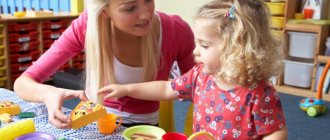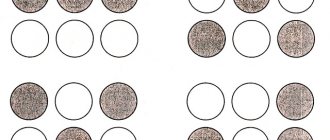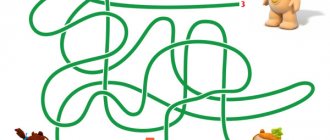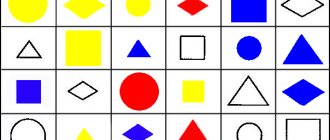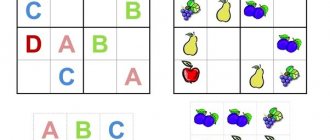- Why does a preschooler need to solve logic problems?
- Rules for solving logic problems for preschoolers
- Logic problems, assignments and games for preschoolers
Task for developing intelligence (for children aged 6, 7 years)
- Tasks for the development of creative abilities
- Logic problems - tests with answers
- Logic problems “Crossings and maneuvers”
- Entertaining tasks to develop logical thinking in preschoolers
The main and important point in the development of a preschooler is the formation of his logical thinking (this is precisely why it is necessary to solve logical problems!). Thanks to logic, you can explain life phenomena to a 5-6-7 year old child and justify your point of view. If you develop the ability to think and act logically in time, the child will definitely become a sane person.
To achieve this goal, parents and educators use various exciting and interesting games, create game situations of a logical nature, which makes classes not only interesting, but also very useful for small pets, as they are aimed at developing intelligence and thinking. Such tasks and games will force the little brain to reason, taking into account, first of all, logic.
We all know that children love to think, trying to show that they are adults. Yes, any adult will notice errors in reasoning, which are associated with an inaccurate logical structure of thought. The child very often reasons correctly and is close to the answer, but due to his lack of logic, it is difficult for him to explain or express his point of view. Adults will help him overcome this obstacle, and in this they will need logic games and tasks (tasks). When the baby finally gains the ability to think logically, he will easily be able to solve simple and complex problems that life will set for him.
Preschool children really like logic puzzles. They are interested in reasoning and flexing their brains. Many children, after reading a logical task, immediately give the correct answer, but not everyone can explain the course of their thoughts. Then the teacher or parent should help the student build a chain of thoughts using the correct methodology for working on tasks with a logical load.
Rules for solving logic problems for preschoolers
1. Spend up to 10 minutes exercising several times a week;
2. During the explanation, it is advisable to use visual materials (drawings, diagrams, tables);
3. Give the child a few minutes for his own reasoning, mandatory collective discussion, exchange of opinions;
4. You don’t have to write down tasks in your notebook;
5. When analyzing a logical problem, it is necessary to pay attention to the initiative and perseverance of students, help them find the answer thanks to correctly posed questions, and also explain beautiful and original solutions;
6. If the task turns out to be difficult, it is advisable to think at home.
Below are logic problems that are constantly used by teachers in their work, and most importantly, preschoolers readily solve them.
Logical problems in mathematics for ingenuity and ingenuity with answers
AWARENESS TASKS
- There were 9 steamships at sea. 2 ships docked at the pier. How many ships are there at sea? (9 ships.)
- There were 7 brothers walking, each brother had one sister. How many people walked? (8 people).
- What kind of dishes can you not eat anything from? (From empty.)
- The animal has 2 right legs, 2 left legs, 2 legs in front, 2 in back. How many legs does an animal have? (4 legs.)
- 9 sharks were swimming in the sea. They saw a school of fish and dived deep. How many sharks swam in the sea? (9 sharks, only they dived.)
- The vase contains 3 tulips and 7 daffodils. How many tulips are there in a vase? (There were 3 tulips in the vase.)
- 7 boys cleared one path in the garden. How many paths did the boys clear? (7 tracks.)
- 2 brothers each drew 2 drawings as a gift to their grandfather. How many drawings did grandfather receive? (4 pictures.)
- The grandmother knitted scarves and mittens for her grandchildren. In total she knitted 3 scarves and 6 mittens. How many grandchildren did your grandmother have? (3 grandchildren - explain the answer.)
- Grandfather, grandmother, granddaughter, Bug, cat and mouse pulled and pulled and finally pulled out the turnip. How many eyes saw the turnip? (12 eyes.)
Children collected an autumn bouquet in the park. It contained 5 maple, 4 birch, 2 oak, 1 aspen leaves. How many different trees did the bouquet come from? (From 4 trees.)
logicheskie_zadachi
Logical tasks and games for preschoolers
Task for developing intelligence (for children aged 6, 7 years)
Among logic games, games for developing ingenuity occupy a significant place. They are lively, interesting, and you can learn a lot of new things from them. Such games allow the child to quickly switch from one activity to another, which helps develop logic. Games of wits help students win by showing their peers what they are capable of. Lazy kids, looking at the victory of others, should try to manifest themselves through trial and error, force themselves to think. Thus, logic games for developing ingenuity are very useful for the overall development of children. Examples of such games.
Game "That's how I am!"
Children form a circle. The presenter points to one of the students and says: “That’s how I am!” After this command, the student begins counting and the players count one by one, but earlier the leader said that instead of some numbers it is necessary to say “That’s how I am!” Such numbers can be numbers that contain the number 6, or numbers divisible by 2, etc. (for example: 1, 2, 3, 4, 5, “that’s how I am,” 7, 8, etc. ). You need to play fast. If a player gets lost, he leaves the game. The counting starts all over again. One player must remain.
Tasks for the development of creative abilities
Unfortunately, very often parents believe that it is impossible to develop logical thinking in a child, since he should have such abilities from birth. This is a wrong assumption. You should look closely at your baby, find hidden talents, and develop these talents from an early age. But in order to better achieve this goal, the child needs to create comfort and a good atmosphere.
Psychologists offer many games for developing creative abilities, in particular coloring books and exercises with completing pictures.
Game “Complete the picture”
Games and exercises to develop thinking in preschool children
2nd junior group (children 3 – 4 years old)
Game “In the garden, in the vegetable garden...”.
Goals: develop classification skills; help explore the order of things.
Game material and visual aids: cards with images of a vegetable garden, garden, forest; figures of vegetables, fruits, berries, mushrooms (cut out of cardboard).
Description: invite the child to correctly distribute the cut out figures, remembering what grows where: vegetables - in the garden, berries and mushrooms - in the forest, fruits - in the garden.
Game “What should we put in the refrigerator?”
Goals: develop classification skills; help explore the order of things.
Game material and visual aids: cards with images of a refrigerator, wardrobe, china cabinet, bookcase, images of objects stored in the refrigerator, wardrobe, etc.
Description: tell your child a story about how one boy decided to indulge himself: he took out all the food from the refrigerator, clothes from the closet, as well as all the dishes and books. All the things were mixed up, and he could not put them back in place, but the boy’s mother would see and be upset. “Let’s help the child and put everything in its place: food next to the refrigerator, clothes near the wardrobe, books near the bookcase, dishes in front of the cupboard.”
Game "Comparison of quantities."
Goal: to develop comparative analysis skills, speech, logical thinking.
Game material and visual aids: wide and narrow strips of paper, cubes.
Description: invite the child to build houses for the mouse and for the bunny: “Do you think we will build them houses of the same size?” Encourage the child to conclude that the mouse’s house should be smaller than the bunny’s house.
After the houses are ready, tell them that the animals asked to put paths in front of their houses for guests. But to prevent guests from getting confused, the path in front of the mouse house should be narrow, and in front of the hare house - wide. Show your child how to determine which of the tracks (paper strips) is wider by placing them on top of each other. Let the child himself distribute the paths between the houses.
Game "What is it like?"
Goal: develop comparison skills.
Description: invite your child to play questions and answers. For example: “What is as round as a ball?” (Watermelon, orange, apple, etc.); “What is as white as snow?”; "What's as sweet as sugar?" etc.
Game “The cow gives...”.
Goal: develop logical thinking through connections.
Game material and visual aids: cards with images of animals, products obtained from animals (milk, eggs, wool, etc.).
Description: Arrange the cards in random order. Invite the child, next to the image of each animal, to put an image of what this animal gives us. For example: chicken - egg, feathers (you can draw a pillow); cow - milk (cottage cheese, sour cream, kefir); goat - downy yarn (draw socks, mittens), etc.
Middle group (children 4 – 5 years old)
Game "Treasure Chest".
Goal: develop analysis skills.
Game material and visual aids: box (bag); any edible (inedible) thing that fits in a box (bag).
Description: ask your child to guess what’s inside using ten questions.
Game "Who was who?"
Goal: develop thinking.
Description: the child must name the state that preceded what the teacher calls him.
For example:
- Who was the old man? (As a boy.)
-What was the tree? (Rostkom.)
-What was Pinocchio? (With logs.)
Game "Guess by description."
Goals: develop thinking.
Description: Prepare riddle sentences in advance that children must answer.
For example:
• A beautiful insect with colorful wings, loves to fly, feeds on nectar. (Butterfly.)
• The transport is long, consists of several parts, runs on iron rails. (Train.)
• Wild animal, lives in the forest, howls at the moon. (Wolf.)
• A wild animal with red fur always deceives in fairy tales. (Fox.)
• Fruit with yellow skin. (Lemon.)
Game "Visual yes-no-ki".
Goals: teach to analyze; develop thinking.
Game material and visual aids: cards with images of objects (animals) or small toys.
Description: place toys or pictures (no more than 10) on the table, give the child a little time to look at them. Then ask: “What object did I wish for?” The child, using leading questions (Is it on the right half of the table? Below? Is it yellow? Is it heavy? Is it round?) identifies the hidden object (picture). To begin with, it is better for the teacher to act as the questioner. This way the child will understand the game script faster.
Game "Third Man".
Goal: to learn to classify objects according to the characteristics specified in the conditions.
Description: the teacher names three words, for example: “dog”, “cat”, “fish”. The child must determine: all three words refer to the designations of wildlife, but “dog” and “cat” designate animals, but “fish” does not. This means that the word fish is “superfluous”. Examples of words: birch, pine, rose; soap, shampoo, toothbrush; milk, kefir, tea.
Senior group (children 5 – 6 years old)
Game "Collect a flower".
Goal: to develop thinking, the ability to analyze and synthesize.
Game material and visual aids: cards depicting objects related to the same concept (clothing, animals, insects, etc.).
Description: each child is given a round card - the middle of the future flower (one - a dress, the second - an elephant, the third - a bee, etc.). Then the game is played in the same way as in lotto: the presenter distributes cards with images of various objects. Each participant must assemble a flower from cards, the petals of which depict objects related to the same concept (clothing, insect, etc.).
Game "Logical endings".
Goal: to develop logical thinking, imagination, ability to analyze.
Description: children are asked to complete the sentences:
• Lemon is sour, and sugar... (sweet).
• You walk with your feet, but throw... (with your hands).
• If the table is higher than the chair, then the chair... (below the table).
• If two are more than one, then one... (less than two).
• If Sasha left the house before Seryozha, then Seryozha... (left later than Sasha).
• If the river is deeper than a stream, then the stream... (smaller than a river).
• If the sister is older than the brother, then the brother... (younger than the sister).
• If the right hand is on the right, then the left hand... (on the left).
• Boys grow up to become men, and girls... (women).
Game "Ornament".
Goal: to develop logical thinking and the ability to analyze.
Game material and visual aids: 4-5 groups of geometric shapes (triangles, squares, rectangles, etc.), cut out of colored cardboard (figures of one group are divided into subgroups differing in color and size).
Description: invite the child to consider how you can create ornaments from geometric shapes on a playing field (sheet of cardboard). Then lay out the ornament (according to a model, according to your own plan, under dictation), using concepts such as “right”, “left”, “above”, “below”.
Game "Helpful - Harmful."
Goal: to develop thinking, imagination, ability to analyze.
Description: consider any object or phenomenon, noting its positive and negative sides, for example: if it rains, this is good, because plants drink water and grow better, but if it rains for too long, this is bad, because plant roots can rot from excess moisture.
Game "Everything that flies."
Goal: develop logical thinking.
Game material and visual aids: several pictures with various objects.
Description: invite the child to select the proposed pictures based on the named characteristic. For example: everything is round or everything is warm, or everything is animate that can fly, etc.
Game "What is it made of"
Goals: develop logical thinking; consolidate the ability to determine what material an object is made of.
Description: the teacher names some material, and the child must list everything that can be made from it. For example: tree. (You can use it to make paper, boards, furniture, toys, dishes, pencils.)
Preparatory group (children 6 – 7 years old)
Game “I take it with me on the road.”
Goal: develop logical thinking.
Game material and visual aids: pictures with images of single objects.
Description: Place images face down. Invite your child to go on a sea voyage. But in order for the trip to be successful, you need to thoroughly prepare for it and stock up on everything you need. Ask your child to take one picture at a time and talk about how this item can be useful. The objects in the pictures should be very different. For example, a child takes out a picture of a ball: “The ball can be played while resting, the ball can be used instead of a lifebuoy because it does not sink, etc.” You can play out various situations: on a desert island, on a train, in a village.
Game “How are they similar and how are they different?”
Goal: develop logical thinking.
Description: the presenter offers the children two objects, the children must compare them and indicate the similarities and differences. For example: plum and peach; little girl and doll; bird and plane; cat and squirrel; an orange and an orange ball of the same size; felt-tip pen and chalk.
Game "Resettlement of birds".
Goal: develop logical thinking.
Game material and visual aids: 20 cards depicting birds: domestic, migratory, wintering, songbirds, birds of prey, etc.
Description: invite the child to place the birds in nests: in one nest - migratory birds, in another - all those who have white plumage, in the third - all birds with long beaks. Which birds were left without a nest? What birds can be placed in several nests?
Game "Associations".
Goal: develop logical thinking.
Description: children are divided into two groups. One group invites the other to talk about an object, using words denoting other objects in their story. For example, talk about carrots using the words: duck, orange, cube, Snow Maiden. (It is the same color as an orange. It can be cut into cubes. Ducks love the top part of it. If you don’t eat it, you will be as pale as the Snow Maiden.) Then the groups change roles. The subject to be described and the words-characteristics are set by the presenter.
Game "Come up with a proposal."
Goals: develop logical thinking, speech activity; develop a sense of language.
Game material and visual aids: ping pong ball.
Description: the teacher sits with the children in a circle and explains the rules of the game. He says some words, and the children come up with a sentence using this word. For example: the teacher calls the word “close” and passes the ball to the child. He takes the ball and quickly answers: “I live close to the kindergarten.” Then the child says his word and passes the ball to the person sitting next to him. So, in turn, the ball passes from one player to another.
Assignments - tests (with answers) for children from 5 years old
Logical tasks also include tasks - tests. These tests contain one correct answer.
Task 1. Kolya, Anya and Nastya went into the forest and found 4 mushrooms. How many mushrooms would the children find if only Kolya and Anechka left?
a) 0; b) 1; at 2; d) 3; e) 4. (Correct answer.)
Solution. The number of mushrooms does not depend on the number of children who found them.
Problem 2. Alice had 3 ribbons. One of them was torn in half. How many ribbons does the girl have now?
a) 1; b) 3; at 4; (Correct answer.) d) 5.
Solution. Alice has two whole ribbons, and from one torn one two were formed. That is, the girl now has: 2 + 2 = 4 ribbons.
Task 3. Kostya wrote OLYA MALA on a piece of paper and went to the mirror. What phrase can you see in the mirror?
a) Olya small; b) SMALL OLIA; c) ALAM YALO; (correct answer.) d YALO ALAM.
Solution. Since all the letters of the written words are symmetrical, they will remain the same letters in the mirror. But they are located in the opposite direction. That is, two words are formed, written from the end. Experiment with paper in front of a mirror.
Problem 4. 8 children were playing in the yard. When mom called for lunch, Mariyka, Dima, Seryozha, Timofey, Uncle Nikolai and Grandfather Nikolai came running to the table from the yard. How many children are left playing in the yard?
a) 2; b) 3; at 5; d) 4. (Correct answer.)
Solution. Among all those who came running to their mother’s call, the children are Masha, Dima, Seryozha and Timofey, that is, four children came running. There are 8 – 4 = 4 children left to play in the yard.
Logic problems “Crossings and maneuvers”
Interesting logic problems are logical crossing problems and maneuvers. These exercises focus on difficult situations involving the crossing of animals or objects. It is necessary to come up with some way or algorithm to do this. They are usually called maneuvers. In crossing tasks, you need to transport something or someone or change places, observing some rules.
Problem 1. Two hungry dragons are resting on the left bank of the stream, and a defenseless kitten Vasya is sitting on the right bank of the stream. The Lord of the Dragons, Uncle Mitya, plies between the banks on his longboat. It is forbidden to leave a dragon and a kitten unattended on one of the banks, and more than one animal cannot be placed on a longboat. How can Uncle Mitya transport the dragons to the right bank and the kitten to the left?
Clue. First of all, the Lord of the Dragons, Uncle Mitya, must take one of the dragons with him.
Solution. To solve the problem, the lord of the dragons really first needs to take one of the dragons with him to the opposite shore, but there is a defenseless kitten sitting on the shore, therefore, having transported the dragon, Mitya will have to take the kitten with him to the opposite shore, on which there is still one dragon left. Uncle Mitya will take this dragon that remains with him and transport it to the right bank, and leave the kitten on the left bank. Thus, the lord of the dragons, Uncle Mitya, will transport the kitten to the left bank and the dragons to the right in three swims.
Problem 2. Two travelers approached the river. On the river bank a boat was found that could carry only one person. However, they were able to cross the river and continue their journey. How could this be?
Clue. Maybe they weren't walking together?
Solution. This is possible if they approached the river from different banks. Then the first crossed to the shore of the second, and the second to the shore of the first.
Task 3. The simplest maneuver exercise is to place three balls in the opposite direction. You can only change two adjacent ones.
The solution is very simple - change the balls one by one until you hold the desired one.
The proposed logic tasks are a good way to develop mathematical thinking and increase the activity of thought. With constant use of these, you can get high positive results in the development of logical thinking.
Logic puzzles for preschoolers 5-6 years old (for attentiveness, memory development)
10 interesting and exciting tasks for preschoolers. Source: www.liveinternet.ru
Task 1: Katya, Galya and Olya drew heroes from the village of Prostokvashino: Pechkin, Sharik and Matroskin. Who drew who, if Katya didn’t draw Pechkin and Sharik, and Galya didn’t draw Pechkin?
Task 2: There is a maple tree. There are two branches on the maple tree, on each branch there are two cherries. How many cherries are there in total?
Problem 3: If a goose stands on two legs, then it weighs 4 kg. How much will a goose weigh if it stands on one leg?
Problem 4: Two sisters have one brother each. How many children are in the family?
Problem 5: A giraffe, a crocodile and a hippopotamus lived in different houses. The giraffe did not live in a red or blue house. The crocodile did not live in a red or orange house. Guess which houses the animals lived in?
Problem 6: Once upon a time there were three girls: Tanya, Lena and Dasha. Tanya is taller than Lena, Lena is taller than Dasha. Which girl is the tallest and which is the shortest? What is the name of which one?
Problem 7: Misha has three carts of different colors: red, yellow and blue. Misha also has three toys: a tumbler, a pyramid and a spinning top. In the red cart he will not carry a spinning top or a pyramid. The yellow one is not a spinning top or a tumbler. What will Misha carry in each of the carts?
Problem 8: The dragonfly is not sitting on a flower or on a leaf. The grasshopper does not sit on a fungus or on a flower. The ladybug is not sitting on a leaf or on a fungus. Who is sitting on what? (It’s better to draw everything.)
Problem 9: Alyosha, Sasha and Misha live on different floors. Alyosha lives neither on the top floor nor on the bottom. Sasha lives neither on the middle floor nor on the bottom. On what floor does each boy live?
Problem 10: Three plates contain different fruits. The bananas are not in a blue or an orange plate. Oranges are not in a blue or pink plate. What plate are the plums in? What about bananas and oranges?
Entertaining tasks to develop logical thinking in preschoolers
A lot of tasks and logic games, as well as puzzles for children from 4 to 7 years old, can be found in the manual by Z.A. Mikhailova "Entertaining tasks for preschoolers."
The manual contains tasks, games, and puzzles for working with children aged 4-7 years. The material is presented in a certain system, which is important for increasing the level of general mental development of children, preparing them for mastering a mathematics course at school, and for creative work in the future.
An example of a logical problem from a book to find a pattern:
Problem with sticks (matches):
Download the manual in pdf format for free
Child development 6 years old: what you need to teach your children
The world around us is changing rapidly, and with it knowledge, professions, and ways to realize one’s potential are changing. Remember how in childhood our parents told us “but in my time...” and then went on to list everything that was different before. Now try to compare your children with yourself at their age. They are bolder, freer, they know more. ⠀ Children are surrounded by an incredible flow of information; the pace of life cannot be compared with what it was 20-30 years ago. And we can give our children the knowledge and skills that will help them now and in the future.
- Initiative and creativity . Willingness to be the first on a new path, the ability to create new things, find innovative solutions to issues and problems - this is what is important today. Just 30 years ago, success was determined by how much you could work within the system and “reproduce the pattern.” In the modern world, the ability to think creatively and freely is useful to everyone. By the way, this is exactly what we teach in our classes.
- Communication skills . The ability to communicate effectively, understand each other as accurately as possible, the ability to present one’s point of view and listen to others. Here we can add intercultural communication - acceptance and understanding of other cultures and traditions.
- Information and technology literacy. The ability to work with information: search, select, analyze and present conclusions, as well as the ability to work with the latest technical devices - no profession in the future will do without these skills. In addition, we must give children knowledge about safe behavior on the Internet.
- Ability to learn and self-teach. Today, learning professional activities extends over a lifetime - this applies to both the opportunity to improve the level in some profession and the opportunity to radically change activities. Without the skill of self-learning, success will be much more difficult to achieve.
- Self-regulation and adaptability. The ability to control your emotions and structure behavior for specific tasks is very important, as well as the ability to be flexible and adapt to changing conditions - you cannot do without this, either now or in the future.
What do you consider an important skill for a 6-year-old? What are the most important tasks for 6-year-old children?
Logic tasks to test the readiness of a 6-7 year old child for school
An excellent collection of logical tasks for preschoolers, developed taking into account the Federal State Educational Standard. In total, this book has five sections with logical tasks - comparison, classification, patterns, spatial thinking, and inference. Each section contains 7-11 exercises, which are best performed in the order in which they are given in the collection.
Download a collection of tests and logic problems for preschoolers in pdf format
Concept of logical thinking
Logical thinking is a physiological process as a result of which a person comes to conclusions based on evidence and prudence.
There are three types of logical judgments.
- Abstract judgment. A person builds conjectures on concepts and properties that cannot be felt. They are not valid, they are in the abstraction.
- Figurative judgment. A person uses his imagination and imagines specific images that occur in life.
- Verbal judgment. People often share their opinions with others. During the conversation, mental analysis occurs, leading to specific conclusions.
Logical thinking begins to develop at an early age. The stages of formation of thinking in the process of child growth will be discussed further.
Logic for children 5 - 7 years old
This manual contains very interesting tasks, assignments, exercises and games for the development of logical thinking in preschool children, aimed at comparing objects according to various criteria, highlighting significant differences between objects, generalization and classification. This book is recommended for use in kindergartens and at home for children to study together with their parents. This manual can be used to prepare for mathematics lessons at school.
Download the manual by Tikhomirova L.F. Logics. Children 5-7 years old in pdf format
Print more tasks for children 6 years old from the site
Follow the links and download more educational tasks for children 6 years old:
- Interesting tasks for creating an agamograph. This is a simple optical illusion that you can create with your own hands. Need to fold paper! For those “advanced” in the field of neat folding: flexagon and origami,
- Coloring books can help you increase your vocabulary, learn colors, and learn how to hold a pencil correctly. Also, coloring books help develop concentration, perseverance and patience in children, the skills of careful work, and clearly demonstrate the quality of painstaking work. And they undoubtedly stimulate creativity in the child!
- Applications and cut-outs: paper dolls, kinetic toys, paper cities, construction sets, houses, paper dolls, riddles, puzzles and much more.
- Graphic patterns in cells for training graphometry, attentiveness, accuracy and basic calligraphy skills.
- Math coloring pages.
- Complex labyrinths.
- Copybooks - numbers, copybooks - printed letters.
- Graphic dictations.
- Paper construction.
- Crafts for children: from paper, cardboard, toilet paper rolls, ice cream sticks, plasticine, DIY toys
A simple logic problem
Petya is weaker than Kolya.
Petya is stronger than Misha. Who is the weakest? Answer: Misha.
Solution Petya is stronger than Misha = Misha is weaker than Petya. Petya is weaker than Kolya, which means Kolya is the strongest.
Clue
It is best to study logic sequentially from simple to complex.
Sources
- https://ChildAge.ru/psihologiya-i-razvitie/razvitie-i-obuchenie/voprosy-na-logiku-dlya-detej-6-7-let-s-otvetami.html
- https://mel.fm/deti/shkolniki/485617-logics_first_grade
- https://child-class.ru/raskraski/logicheskie-zadachi-dlya-doshkolnikov
- https://kladraz.ru/podgotovka-k-shkole/zadanija-na-logiku-dlja-detei-6-7-let-v-kartinkah.html
- https://www.fun-edu.ru/poleznye-materialy/logicheskie-zadachi-dlya-detej-6-7-let-otvety-vnutri/
- https://logiclike.com/math-logic/6-7-let/logicheskie-zadachi
[collapse]
Logic puzzles for older preschoolers
Task No. 1
Sheep, Puppy and Squirrel were asked to combine the figures into three groups - according to one common characteristic. The animals completed the task successfully, but each group turned out to be different. Combine the shapes into three groups in three ways.
Task No. 2
The artist mixed up all the sizes. List the objects from smallest to largest according to their actual size.
Answer: ball, hare, horse, boat, whale.
Task No. 3
The turtle was in such a hurry that he lost things from his suitcase along the way. Follow the same path and find out where he was hurrying. Write your answer in the empty boxes.
Answer: on a plane.
Task No. 4
Monkey, Piglet, Mishutka and Tiger Cub live in the same house. These are their windows. The monkey lives above Mishutka. And to the right of Mishutka lives Piglet. Tell me where whose window is.
Answer: Monkey lives in the upper left window, Tiger Cub lives in the upper right window, Teddy Bear lives in the lower left window, and Piglet lives in the lower right window.
Task No. 5
Morning has come. Each of the animals looked out the window. Redraw the animals in cells on the next page - each in its own window.
Task No. 6
The bunnies can't figure out whose carrot is whose. Help them: find which carrot each bunnie has a piece of.
Task No. 7
Hedgehog and Squirrel went to the forest. What will each of them collect there? Find out by rearranging the letters. Write your answers in the empty boxes. Complete the picture.
Task No. 8
A cat with a sweet tooth tried to fit a very large chocolate bar into a very small pocket - and it broke. Assemble a tile from three parts. Which part is missing?
Task No. 9
The bunnies Tisha and Timosha have a birthday. Tiger cub Tosha prepared a gift - two identical drawings. But the rain washed away some details. Complete the drawings so that they are the same again.
Task No. 10
The crow Carlita knows more than a hundred words that begin with KAR. How many words in KAR do you know? Fill in the lines.
Task No. 11
Sparrow, Bunny, Raccoon and Fox take part in the competition "The Biggest Snowman". Each of them makes a snow globe. Sparrow's ball is not the largest. The Bunny has a smaller ball than the Sparrow, but larger than the Little Fox. What size ball did each of the animals make? Match the animals with their balls. Who do you think will win the competition?
Answer: the largest ball was made by the Raccoon, the second largest ball was made by the Sparrow, the third by the Bunny, and the smallest by the Little Fox.
Task No. 12
The little bear doesn't know how to fill out the tables. Help him: draw the missing elements.
Task No. 13
A baby elephant works as an artist in Africa. In this table he wrote down those whom he should draw. Look who the Baby Elephant has already drawn. Cross out the names of these animals from the table. By making a word from the extra letters, find out who the Baby Elephant has not yet drawn. Write your answer in the empty boxes.
Task No. 14
Pava the fox found her old photograph. Help Pava glue it together: find the missing fragment.
Task No. 15
The sheep Byasha, Dunyasha and Malasha are great fashionistas. They were very upset when they saw that they were wearing the same bows. Using only two pencils, color the bows of each of the sheep so that Byasha, Dunyasha and Malasha are different from each other.
Task No. 16
The squirrel thinks that there are two triangles and four rectangles in the picture. Surprise her: find seven triangles and nine rectangles in the picture.
The little fox does not believe that this figure can be divided into six triangles using two lines. Show him how to do it.
Task No. 17
The bees are very angry. Someone stole all the honey from the hive. Decipher the word and you will find out who ate the honey. Write your answer in the empty boxes.
Answer: bear.
Task No. 18
The bunny doesn't know what these items are made of. Hint him: combine the objects into pairs depending on what material they are made of.
Answer: the bag and pillows are made of fabric, the sword and keys are made of metal, the paper and stool are made of wood, the cup and vase are made of clay.
Task No. 19
Little elephant Styopa decided to paint the fence and even came up with a pattern for it. Help him: paint the fence according to the pattern.
Task No. 20
The Serpent Gorynych has three heads, so he divides everything into three parts, even words. By rearranging the parts of the word, find out what the Serpent Gorynych is going to eat. What letter does the middle head of the Serpent Gorynych not pronounce? Write the resulting word in the empty cells.
Answer: ice cream
Task No. 21
Caterpillars participate in a beauty contest. The winner should be the longest caterpillar. Color the caterpillars and measure them using a thread and a ruler. Who will take what place? Write the appropriate numbers in the empty boxes.
Task No. 22
It's easy to lose your shadow in a fairytale forest. Help the forest children: determine where whose shadow is.
Task No. 23
The little fox loves to fish. Help him choose a place where there are the most fish and place a fishing net. Using three selected points, construct four possible triangles and select the one with more fish inside.
Task No. 24
The Evil Witch is so evil that she scares children with her very appearance. Color the Evil One so that she becomes funny, not scary.
Task No. 25
Evil is brewing her best potion. She wants to treat some witches she knows to it. All recipes in her cookbook are encrypted. Using the key to the cipher, find out what Evil's potion consists of.
Answer: dragon shadow, moonlight, bat cry.
Task No. 26
On Begemosha's name day, all the animals came by invitation, and only one guest got to the holiday by accident. Who's the odd one out in the picture? Help Begemosha find the uninvited guest.
Answer: the extra one in the picture is a puppy, since it is a domestic animal, and the rest are wild.
Task No. 27
Fox, Bunny and Puppy bought three balloons: green, yellow and blue. The Chanterelle's ball is not blue, the Bunny's ball is not green, and the Puppy's ball is neither green nor yellow. What color is the ball for each animal? Color the balls in the appropriate colors.
Answer: The Fox has a green ball, the Bunny has a yellow ball, and the Puppy has a blue ball.
Task No. 28
Iya the frog loves to travel. She also loves the letter “I”. After solving the puzzles, find out which countries Iya has visited. Fill in the blanks. Which word is missing?
Answer: Spain, Italy, Irkutsk. An extra word is “Irkutsk”, since this is not a country, but a city.
Task No. 29
The absent-minded artist forgot to color his drawing. Color the picture using the clue numbers.
Task No. 30
At school, Bunny was asked to learn a saying. But the bully Wolf rearranged the words of the text, and now Bunny cannot read the saying. Help him: put the words in the right order.
Answer: the cowardly bunny and the stump of the wolf.
Task No. 31
Only Mother Bear can tell the twin cubs Venya and Senya from each other. Can you do it? Look at the picture and find at least ten differences.
Task No. 32
Every morning Sunny comes to visit. Who is it rushing to this time? Help Sunny find the way, and read the answer along the way. Write your answer in the empty boxes.
Answer: to you.
Pattern search tasks
A mathematical pattern is a specific rule according to which in a numerical, figurative or other series of components there is a repetition or a change in the components themselves or their qualities in accordance with the established rule.
By solving this type of puzzle, a child can learn:
- What are patterns and their varieties.
- What you need to start doing the puzzle.
- How conclusions are drawn about which number, symbol or figure should continue the presented series.
Examples:
Task 1. Find a suitable number series.
The scientist bought a new notebook to write down his secret experiments. When the week comes to an end, he notes how many experiments he has completed. Find a number series that matches this condition.
- 1, 4, 4, 2, 5, 6
- 3, 5, 7, 7, 10
- 1, 2, 5, 15, 18
- 7, 3, 5, 5, 3, 14
Answer: 3, 5, 7, 7, 10 and 1, 2, 5, 15, 18.
It is possible that the numbers will be completely different. However, each subsequent number must be higher or remain the same (if the scientist did not conduct experiments on the day of recording).
Task 2. Establish a pattern and extend the number series.
In order for the scientist to continue conducting experiments, he needs to help establish a pattern in the series. Help the scientist and extend the row by 2 numbers.
23, 23, 21, 25, 19, 27 …
Answer: 17, 29
From the very beginning, in the pattern, each number is 2 less than the previous one, and then - 2 more than the previous one.
What tasks to give first graders
Already at preschool age, 4–5 years, most can understand simple logical operations such as comparison or classification. In the first grade of school, it is especially important to pay enough attention to solving logical problems - this will ensure successful development of the school curriculum as a whole. Like any skill, logical reasoning can be trained.
It is especially important to teach first-graders how to work correctly with syllogisms. A syllogism is a logical conclusion in which a third judgment (conclusion) is obtained from two given judgments (or premises). The classic syllogism that is usually taught in logic lessons is the following:
- Every person is mortal (premise 1).
- Socrates is a man (premise 2).
- Consequently, Socrates is mortal (conclusion deduced from the premises).
Of course, with children, such logical reasoning should be practiced on subjects that are closer to them - for example, on puzzles and riddles about toys or sweets.
When solving logic problems with your child, do not forget to praise him for the correct answers and support him. It is important that the child has positive reinforcement and associates solving logical problems with pleasure and play, and not with obligation.

